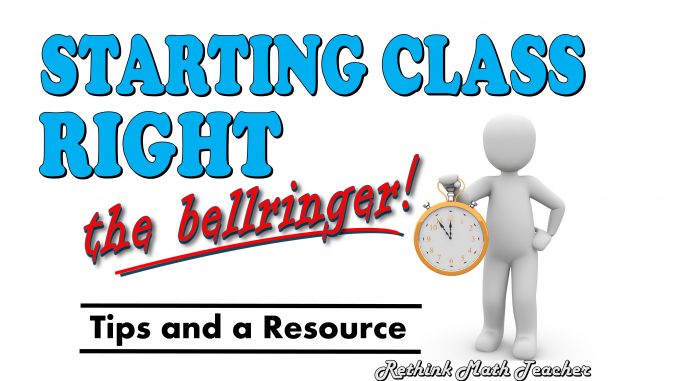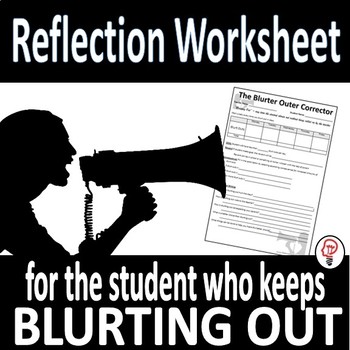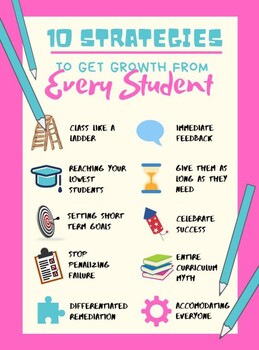
Would you believe that one of the most effective strategies that you can implement that will help ensure quality instruction and effective classroom management is to start the class correctly?
In his fantastic book on classroom management, The First Days of School, Dr. Henry Wong shares with the reader the importance of beginning the period right. He says he stands at the door, professionally dressed, and shakes each student’s hand with a smile. When they enter the room, there are questions on the board that the students are supposed to immediately begin working on, called a “bellringer” or a “Do Now.”
If students don’t enter the room correctly, or don’t begin immediately working on the Bellringer, they are asked to exit and try again.
While students work on the Do Now, the teacher takes attendance and takes care of any administrative tasks that need to be done.
I would like to add several tips to this routine to help you have a successful day, every day!

Tip 1: Compiling the Work
I have seen many teachers collect the student’s work at the end of each period. For me, this seems like a huge waste of paper! The teacher does this so that they can grade the work quickly, and return it. But I have other methods that can accomplish this task.
So I have the students compile the week’s work on one sheet of paper. This way we save time every day, by me not having to collect the paper, students can reference previous problems, and we can save a few trees!
The problem, however, came when I sat down to grade the papers. Honestly! Why is so hard to number problems? Or right on the lines? Where did number three go? And how come there are 2 problems on the top half of the paper, and the last 10 on the bottom half?
My students always struggled with tracking, spacing, and general presentation of the paper. Which made grading it a nightmare. I would spend so much time trying to figure out where each problem was located, and where the answers were. So I created a Do Now Tracking paper, where the students can do each question in a box, and then record the answers on the side. Easy to follow, easy to grade!
Download for free on Rethink Math Teacher’s TpT Page.
Tip 2: Instant Feedback
When learning a new skill, or reviewing one you’re still trying to master – you need instant feedback to know whether or not you are doing the problem correctly. So if you are giving three problems for the Do Now, and then collecting the student’s work, even if you return it the next day, it is losing its value. Students need to learn from their mistakes, and know that they are making them.
This is why I go over the Do Now immediately, in class, while students still have their papers. This way they can see their work and know whether or not they are doing it correctly, and they can learn from their mistakes if they are making any.
You might be saying, “Well then my students won’t do it, because they know I’m going to give them the answers.” Well, first, I have some tips for that, keep reading. And second, I the value of immediate feedback is still worth it, you have to get the students to buy in to this. Emphasize that they should do it because there’s no penalty for getting it wrong, and this is a great learning opportunity.
Tip 3: Maximize Time (don’t copy the word problem!)
I often see teachers put a Do Now on the board that is a word problem (which is a great thing to do), but then the assignment is for the students to copy the word problem and then solve. What a waste of precious class time.
Think of how long it takes to copy that word problem? Let’s say it’s 3 minutes (though it’s really, probably 5). If you do that every day for a week, that’s 15 – 25 minutes of class time spent copying word problems off the board. That’s a lot of valuable time that you could have used teaching a new skill, or practicing one that students have not yet mastered.
We learn through repetition and feedback, not through copying word problems. Instead of spending that time copying a word problem, give them several problems to do. If they don’t have to copy the sentence, they can probably do three or four in the same amount of time. The extra repetitions will help the student master the skill.
Tip 4: Circular Review
I strongly recommend weaving questions in from the entire year into your Do Now (Bellringer). When my students enter the room, there are 3 to 6 Do Now questions on the board, at least one is a word problem (or test like question) and half are from previously taught concepts, so that the students don’t forget them.
The end of the year diagnostic will be over standards from the whole year. Instead of teaching something at the beginning of the year, and then not doing it again until right before the test when you try to cram everything back into their heads – review it weekly, or biweekly, so that it stays fresh.

Tip 5: Transition to a Lesson
The last question of my Do Now is always the new skill we will be working on that day. So they may not be able to do the problem, or maybe they can and we build on it to discuss today’s lesson.
But this makes a nice smooth transition from the Bellringer to the Do Now. Since I review most (if not all) the Do Now questions at the end of the period.
Tip 6: The Golden Marker of Extra Credit
It’s not really gold…. and it’s not really a marker (it’s usually a highlighter). Anyhow….
Here’s one tip that I love, love, love! After I have taken role I grab my ‘Golden Marker of Extra Credit,’ and circulate the room, looking for students working as expected. When I find them, I put extra credit points on top of their paper. (Okay, the marker isn’t really gold, it’s whatever colored marker or pen I can find, but that’s not the point!)
I am always amazed at how much students will do for extra credit. Sometimes teachers will complain to me that their students won’t do the work they assigned. I tell them, “Just call it ‘extra-credit.’ You’ll be surprised at how just changing its name will increase participation.”
I give extra credit to students who are working on their Bellringer, with their own pencil and paper, and who have done so without talking to their neighbor or having to be reminded how to enter the room.
This strategy works! I teach at an inner-city Title 1 middle school in South Florida, and my students love it. Sometimes, I also give out little treats or candy – this is obviously more effective, but sometimes frowned upon by administrators. So I don’t do it often.

Tip 7: Grading the Paper as You Circulate the Room
As I’m walking around the room with my Golden Marker of Extra Credit, I will make notes on students’ papers to make the grading process easier.
For example, if I see that a student did all 5 questions right, I will put a check by each question. That way, when I’m grading their work, and I see my 5 check marks, I know that I don’t need to review those questions, they were done properly and I can move on.
Another example, if someone did question 8 wrong, I might put an arrow to the answer, or make a note on what they need to do to get the correct answer. Then, while grading, I just need to check to see if they fixed that mistake. These tips help the students as they’re doing the work, and they help me when I’m grading the papers.
Don’t forget to download the free student worksheet








